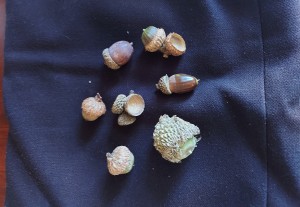 We have just passed the autumn equinox, which marks the official end of summer and the start of fall. We are also halfway to the winter solstice, which is the shortest and therefore darkest day of the year. Many cultures in the Northern Hemisphere celebrate the harvest around the time of the autumn equinox. In the United States we wait until the end of November to celebrate Thanksgiving, but the pumpkins, apples and pears are everywhere and the harvest is coming in.
We have just passed the autumn equinox, which marks the official end of summer and the start of fall. We are also halfway to the winter solstice, which is the shortest and therefore darkest day of the year. Many cultures in the Northern Hemisphere celebrate the harvest around the time of the autumn equinox. In the United States we wait until the end of November to celebrate Thanksgiving, but the pumpkins, apples and pears are everywhere and the harvest is coming in.
So are the acorns.
I can’t write about the autumn equinox without mentioning that it is also a time when millions of small objects fall from the sky. The squirrels are happy because the ground is littered with delicacies like acorns, beechnuts and horse chestnuts. They will proceed to stuff their faces with those nuts, planting the excess in my garden beds while I am planting the spring-flowering bulbs. I feel the squirrels’ and chipmunks’ joy, but I also feel a certain amount of pain on my daily walks.
In early fall, navigating the streets means avoiding two sets of seasonal hazards. The first is airborne, as the slightest breeze brings down an avalanche of litter from the trees. Some of that litter—especially the solid little acorns and the horse chestnuts with their spiky husks–inevitably bounce off people, animals and the hoods of vehicles. The damage is generally minimal, but the sensation of bombardment is real. Eventually those chestnuts and acorns fall to earth, where they accumulate on streets and sidewalks, making life harder for pedestrians like me. Stepping the wrong way on a big horse chestnut can send you sprawling and most adults don’t bounce the way they did when they were twelve.
That said, I am especially fascinated by acorns. The Quercus or oak universe is large—home to about 500 species–and each one bears acorns of slightly different sizes, shapes and colors. The other day I saw a big healthy tree that was most likely a turkey oak or Quercus cerris. The acorn caps are singularly shaggy looking, because the scales that cover them are reflexed or back-turned. The wild mops of scales almost overpower the nuts beneath them.
Reflexed scales also appear on the less common Quercus macrocarpa or bur oak. Bur oaks are large trees that can soar to 80 feet tall. Their acorns are not as crazy-looking as those of the turkey oak, but the bottom few rows of scales are reflexed, making them look like an extravagant fringe that hides the nut.
In my part of the world it is easy to find pin oak, or Quercus palustris. Its leaves are distinguished by narrow, elongated lobes, which contrast dramatically with the more rounded lobes of other oak species. The distinctive acorns are plump things. The caps and nuts are equally visible, and each acorn is wider than it is tall.
Scarlet oak or Quercus coccinea bears acorns shaped like chocolate kisses. The caps virtually overwhelm the nuts, which peak shyly from underneath. I think they are among the most interesting acorns, but the tree itself is magnificent in fall, when the glossy green summer leaves turn scarlet. These kiss-like acorns are very different from those of red oak—Quercus rubra—which feature narrow caps that sit like brown berets atop plump nuts. Red oak also colors dramatically in fall. The leaves of scarlet and red oak are somewhat similar, so the differences in acorns make identification easier.
The lordly English oak or Quercus robur is a stalwart of European landscapes, but less seen in North America. The leaves do not offer much in the form of fall color, but the acorns are distinctive. The tuque-shaped cap tops an elongated nut that may be two or three times the height of the cap. This same cap/nut configuration happens on Quercus acuta, the Japanese Evergreen oak, a relatively little-known tree with foliage that belies its membership in the oak genus. Long and narrow, the leaves are not lobed at all, making identification harder except when acorns are present.
White oak—Quercus alba—acorns also feature relatively thin caps and nuts that are much taller than the caps, though not as slender as those on English or Japanese evergreen oaks.
When I was a child, my sister and I used to collect acorns and chestnuts, accumulating bucketsful over the course of the fall. After a certain period of time—usually by the middle of January—my mother would discretely dispose of all those seasonal treasures. Generally we did not even notice.
If you have a child handy, it is fun to go out for a walk or a trip to a nearby park and see how many different kinds of acorns you can find. Remember that the ones that are paired on a single stem will provide good luck in addition to botanical interest.
You might need that good luck to avoid being toppled by the chestnuts that fall in your path.
